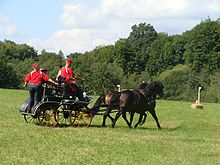Hutsul
| Hutsul | |
|---|---|

Huzule at the stud in Tarnawa Niżna in the upper San Valley ( Tarnawa Niżna , Powiat Bieszczadzki ) |
|
| Important data | |
| Origin: | Huculei |
| Main breeding area: | Eastern Europe |
| Distribution: | especially Eastern Europe |
| Stick measure : | 125-147 cm |
| Colors : | especially bay, dun and piebald |
| Main application area: | Carrying horses and draft horses |
The Huzule (also Old Austrian Huzule ) is a pony breed and comes from the "Huzulei", an area in the Eastern Carpathians north of the Bistritz river , where the Hutsuls have settled as mountain farmers.
Background information on horse evaluation and breeding can be found under: Exterior , interior and horse breeding .
Exterior
The Huzule is a mostly fawn, brown or piebald pony with a stick measure of 125 cm to 147 cm. Other colors are rare, molds are not allowed for breeding. The long, straight head with a straight or slightly concave profile, strong gaiters, small ears, lively eyes and large nostrils stands on a short, strong neck with a strong lower neck, which gives it only moderate erection. The poorly developed, broad withers are followed by a strong back and a short, sloping croup with a low-set tail. It has a strong, steep and short shoulder and a broad, deep and long trunk. The hard, dry limbs stand on small, very hard hooves. Hutsul often have light saber legs and cow hocks, and the hocks are often defective. The deficiencies could be partially compensated for by finishing with Arabs.
interior
The Hucul is considered to be extremely robust, healthy and durable as well as having a strong instinct. His friendly character, the proverbial strong nerves and surefootedness make him an almost ideal trail riding horse. He is also docile and willing to work.
Breeding history
The mountain ponies lived semi-wild there in the Hutsulei and served the people as carrying and draft animals. Their coat color is mostly brown, Isabel or dun . They often have wild horse badges such as shoulder cross , eel line and black fetlock stripes , which suggests that they are still closely related to the ancient wild horse Tarpan .
Around 1870 they began to cross Hutsuls with Koniks , Arabs and English stallions in the Vorwerk Luczyna of the Imperial and Royal Radautz State Stud for the Imperial and Royal Military . This made the horses bigger, but lost their toughness and toughness.
After the First World War , the stock was distributed to Czechoslovakia, Hungary, Poland and Romania. At the suggestion of Rittmeister Michał Holländer (from Sudowa Wyschnja ), a stud book was founded in the "Huzulei" in 1924. In the meantime the Hutsul is being bred pure again. There are the following state studs for breeding the Huzul:
- Romania : Lucina (to the municipality of Moldova-Sulița)
- Poland : Gładyszów, Odrzechowa
- Slovakia : Topoľčianky
- Hungary : Aggtelek
The horse breed has been listed by the Republic of Austria as part of the program for environmentally friendly agriculture since 2001 as a horse breed that is threatened with extinction and worth preserving.
use
They used to be the farmers' all-purpose horses. Today they are mainly used as carrying animals and draft horses in front of carriages. They are also very popular as persistent, sure-footed trail riding horses.

